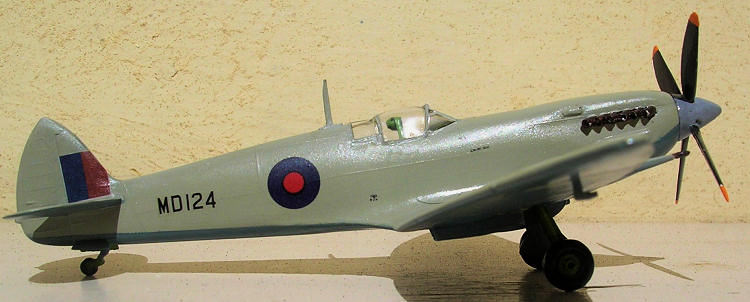
| HISTORY |
KP/Airform 1/72 Spitfire VII (conversion)
| KIT #: | ? |
| PRICE: | $ |
| DECALS: | None |
| REVIEWER: | Carmel J. Attard |
| NOTES: | Airform conversion set had no decals and set catered for other versions of the Spitfire. |

| HISTORY |
During WWII many variants of the Spitfire were developed with generally
improvement in performance of the plane. The Spitfire was a streamlined slim
aircrraft with elliptical wing, which fought on all fronts in WWII. There were
numerous conversions of the basic construction, thanks to the great adoptability
of the airframe. By mid 1942 it was time to improve further the Spitfire
performance as the rival German FW 190 was by then proving superior to the
Spitfire. This was done by installing the new Merlin 61 engine with four-blade
airscrews propeller in a basically Mk V airframe that proved more than a match
for
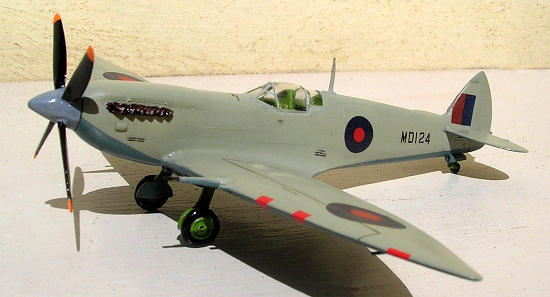
| THE KIT |
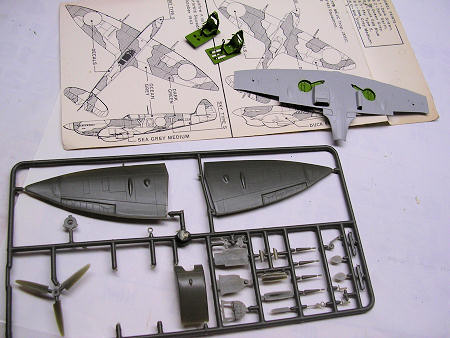 The conversion kit to make a Spitfire Mk
The conversion kit to make a Spitfire Mk
| CONSTRUCTION |
Like any project I had to make a decision so that things go on smoothly
and decided to go ahead with what I had. I just wanted to have the Spitfire
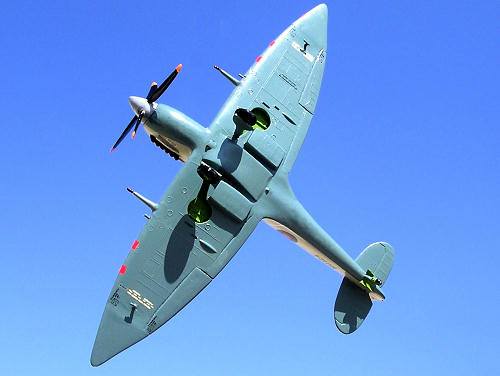 extended
wing span with the taper pointed wing tips which along with more powerful engine
gave the Spitfire type high altitude service performance. In doing so I noticed
that these had slightly smaller wing ailerons. Any surface detail that
disappeared during the smoothening of the surface combination was then
re-scribed while the joining areas were treated with a small amount of filler.
The exhaust stacks on both sides were then drilled open with a 1mm diameter
drill. The assembled new cockpit was then fitted inside the fuselage half, paint
detail applied and the fuselage halves closed. The rest will follow as per KP
kit instructions.
extended
wing span with the taper pointed wing tips which along with more powerful engine
gave the Spitfire type high altitude service performance. In doing so I noticed
that these had slightly smaller wing ailerons. Any surface detail that
disappeared during the smoothening of the surface combination was then
re-scribed while the joining areas were treated with a small amount of filler.
The exhaust stacks on both sides were then drilled open with a 1mm diameter
drill. The assembled new cockpit was then fitted inside the fuselage half, paint
detail applied and the fuselage halves closed. The rest will follow as per KP
kit instructions.
I did not go into the gory detail of drilling open the rear tail
wheel well for the retractable tail wheel as the area at this scale was so small
but instead filed flat a recess covering the well length and drilled a hole to
insert the tail wheel followed by fitting in place the tail wheel doors that
came with the conversion kit. The leading edge guns were also replaced with new
ones provided and an air intake scoop added to the mid lower fuselage while a
90-gallon belly tank was fixed in place. A metal aerial was shaped with a flat
file to a pointed taper top end and inserted in a predrilled hole aft of the
cockpit. I also used surgical tubes for the outer gun barrels that were inserted
in holes drilled at their location on the leading edge. Two under wing pitot
tubes (instead of one, as stated earlier) were fitted as carried by the Mk
| COLORS & MARKINGS |
The high
altitude Spitfire was finished in light gray upper surface camouflage using
Compucolor brand paint bought 25 years ago. This was followed by carefully
masking using Tamiya masking tape and wide areas taped with blank paper. Using
blank 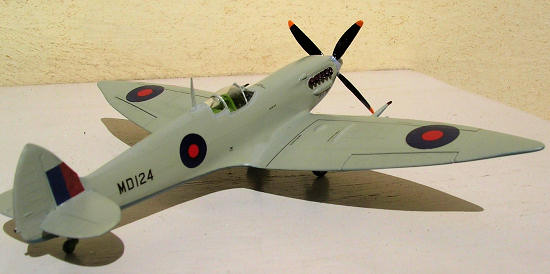 paper to mask already painted areas may be a measure to economize on
Tamiya tape but more to avoid any possible chance that the tape might pull the
already airbrushed smooth light gray considering I was using tins of paint
bought long ago. All the under wings and undersurfaces were then airbrushed in
PRU blue again using Compucolor brand of paint being amazed at how it retained
its consistency quality properties in spite of age. The interiors of wheel well,
cockpit and wheel legs were in interior green and zinc chromate finish using
Humbrol brand.
paper to mask already painted areas may be a measure to economize on
Tamiya tape but more to avoid any possible chance that the tape might pull the
already airbrushed smooth light gray considering I was using tins of paint
bought long ago. All the under wings and undersurfaces were then airbrushed in
PRU blue again using Compucolor brand of paint being amazed at how it retained
its consistency quality properties in spite of age. The interiors of wheel well,
cockpit and wheel legs were in interior green and zinc chromate finish using
Humbrol brand.
The kit was given an overall coat of Klear prior to adding decals. Stenciling decals that appear above and below the wings came from an extensive stash of Extradecal sheets and Modeldecal sheets that I’ve collected over the years. Appropriate roundels also came from the spare decal box, mainly Modeldecal brand. The kit was in the end given an overall semi gloss Micro finish giving the kit the fine sheen it seems to wear in photos of the full-scale aircraft.
| COLORS & MARKINGS |
This was an uncomplicated and fast conversion considering that it basically involved principally a replacement wing. Very little effort was at all needed for this somewhat long ago release conversion set yet it provided a not so common type of Spitfire which differed so much from other types like the MkVb.
| REFERENCES |
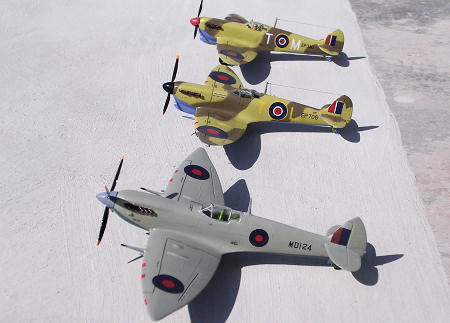 Spitfire-the story of a Famous fighter. A
Harleyford Publication by Bruce Robertson.
Spitfire-the story of a Famous fighter. A
Harleyford Publication by Bruce Robertson.
September 2009
Copyright ModelingMadness.com. All rights reserved. No reproduction in any form without express permission from the editor.
If you would like your product reviewed fairly and quickly, please contact the editor or see other details in the Note to Contributors.